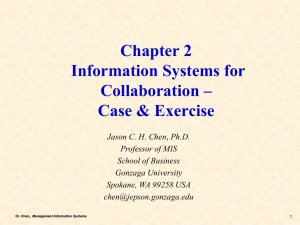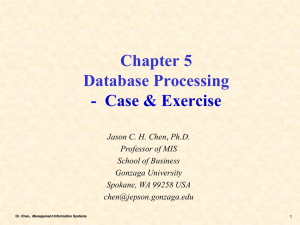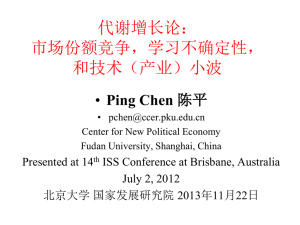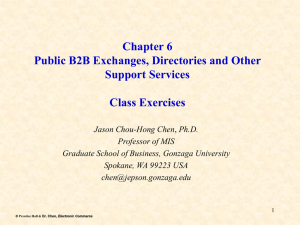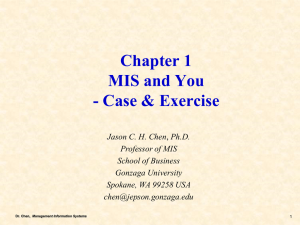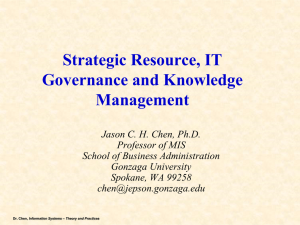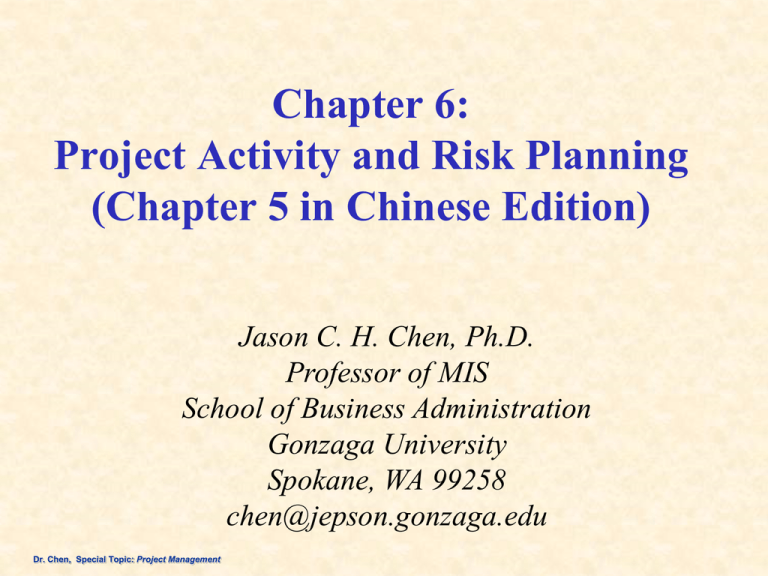
Chapter 6:
Project Activity and Risk Planning
(Chapter 5 in Chinese Edition)
Jason C. H. Chen, Ph.D.
Professor of MIS
School of Business Administration
Gonzaga University
Spokane, WA 99258
chen@jepson.gonzaga.edu
Dr. Chen, Special Topic: Project Management
Part II
Project Planning
Dr. Chen, Special Topic: Project Management
Project Management
Dr. Chen, Special Topic: Project Management
Why do Projects Fail?
Studies have shown that the following factors
contribute significantly to project failure:
• Improper focus of the project management system
• Wrong level of detail
• Lack of understanding about project management
tools; too much reliance on project management
software
• Too many people
• Poor communication
• Rewarding the wrong actions
Dr. Chen, Special Topic: Project Management
4
Project Triangle
(Project Management Trade-offs)
Cost
Time
The center of
project triangle
is
QUALITY
Scope
The objective of the PM is to define project’s scope realistically and ultimately
deliver quality of product/service on time, on budget and within scope.
Dr. Chen, Special Topic: Project Management
Why Planning?
Reasons for Planning
• To eliminate or reduce uncertainty
• To improve efficiency of the operation
• To obtain a better understanding of the
objectives
• To provide a basis for monitoring and
controlling work
Dr. Chen, Special Topic: Project Management
6
MOST MANAGERS DO NOT LIKE
PLANNING DUE TO THE
FOLLOWING:
It takes time.
You have to think.
It involves paper work.
You are bound to systematic
procedures.
You are committed to achieve a specific
result within a specified time period.
Dr. Chen, Special Topic: Project Management
7
Effective Planning
An effective plan will be:
Explicit
stated in detail, leaving nothing merely
implied.
Intelligible it must be understood and be comprehensible.
Flexible capable of accepting change.
Controllable capable of being monitored for control
purposes.
Dr. Chen, Special Topic: Project Management
8
DEFINITION OF A PROJECT LIFE
CYCLE
FEASIBILITY AND
PRELIMINARY
PLANNING PHASE
DETAILED
IMPLEMENTATION
PLANNING PHASE
PHASE
RESOURCES
CONCEPTUAL
PHASE
PMO
PMO
Resources
Utilized
TIME
Dr. Chen, Special Topic: Project Management
CONVERSION
OR TERMINATION
PHASE
PMO: Project Management Office
PLANNING QUESTIONS OFTEN ASKED
* Who plans the project?
* Who executes the project?
* Who is responsible for monitoring work and
controlling work?
* Who is responsible for providing feedback
regarding the planning and execution phases of
a project?
The Line Manager(s) ?
The Project Manager ?
Both Parties ?
Dr. Chen, Special Topic: Project Management
10
Project Manager vs. Line Manager
• A Project Manager manages the work taken up by a
single project whereas the Line Manager will be
managing the work taken up by a line of projects.
• The Line manager will interact/liase with the Project
Managers who manage the projects that fall in his
line.
• Usually projects in organizations are aligned based
on the line of business, catered to, by the project.
Hence, they will have a Line Manager who manages
all those projects.
Dr. Chen, Special Topic: Project Management
11
Project Manager’s
Responsibility
• Project Manager will define:
– Goals and objectives
– Major milestones
– Requirements
– Ground rules and assumptions
– Time, cost, and performance constraints
– Operating procedures
– Administrative policy
– Reporting requirements
Dr. Chen, Special Topic: Project Management
12
Line Manager’s Responsibility
• Line manager will define:
– Detailed task descriptions to implement
objectives, requirements, and milestones
– Detailed schedules and manpower
allocations to support budget and schedule
– Identification of areas of risk, uncertainty,
and conflict
Dr. Chen, Special Topic: Project Management
13
6.1 Initial Project Coordination and the
Project Charter
•
•
•
Early meetings are used to decide on
participating in the project
Used to “flesh out” the nature of the
project
Outcomes include:
–
–
–
–
Technical scope
Areas of responsibility
Delivery dates or budgets
Risk management group
Dr. Chen, Special Topic: Project Management
14
Outside Clients
• When it is for outside clients, specifications
cannot be changed without the client’s
permission
• Client may place budget constraints on the
project
• May be competing against other firms
Dr. Chen, Special Topic: Project Management
15
Project Charter Elements
•
•
•
•
•
•
•
•
Purpose
Objectives
Overview
Schedules
Resources
Personnel
Risk management plans
Evaluation methods
Dr. Chen, Special Topic: Project Management
16
Systems Integration
•
•
•
Performance
Effectiveness
Cost
Dr. Chen, Special Topic: Project Management
17
6.2 Starting the Project Plan:
The Work Breakdown Structure (WBS)
• A hierarchical planning process
• Breaks tasks down into successively finer
levels of detail
• Continues until all meaningful tasks or
work packages have been identified
• These make tracking the work easier
• Need separate budget/schedule for each task
or work package
Dr. Chen, Special Topic: Project Management
18
Hierarchical Planning
• Major tasks are listed
• Each major task is broken down into detail
• This continues until all the activities to be
completed are listed
• Need to know which activities “depend on”
other activities
Dr. Chen, Special Topic: Project Management
19
A Form to Assist Hierarchical Planning
Figure 6-2
Dr. Chen, Special Topic: Project Management
Work Breakdown Structure
(WBS)
Dr. Chen, Special Topic: Project Management
21
A
Visual
WBS
Dr. Chen, Special Topic: Project Management
Figure 6-3 WBS with account numbers shown
Career
Day
Dr. Chen, Special Topic: Project Management
Figure 6-4 Partial WBS for college “Career Day”
The WBS
•
•
•
•
•
•
What is to be done
When it is to be started and finished
Who is going to do it
Some activities must be done sequentially
Some activities may be done simultaneously
Many things must happen when and how
they are supposed to happen
• Each detail is uncertain and subjected to risk
Dr. Chen, Special Topic: Project Management
24
PURPOSE OF WBS
It is to STRUCTURE an ASSIGNED PROJECT into
VARIOUS ACTIVITIES in ORDER that:
• Detailed planning can be performed
• Costs and budgets can be established
• Objectives can be linked to available
resources in a logical manner
• Specific authority and responsibility can be
assigned
Dr. Chen, Special Topic: Project Management
25
WORK BREAKDOWN STRUCTURE (WBS)
LEVEL DESCRIPTION
1
2
3
4
5
6
Total Program
Project(s)
Task(s)
Subtask(s)
Work Package(s)
Level of Effort
Most common type: Six-Level Indentured Structure
Dr. Chen, Special Topic: Project Management
THE WBS BREAKS WORK DOWN INTO
SMALLER ACTIVITIES THUS REDUCING THE
RISK THAT ANY MAJOR OR MINOR ITEM WILL
BE OMITTED
WBS: SIX-LEVEL STRUCTURE
LEVELS
RESPONSIBILITY
1
Usually specified by the client and
2
managed the project manager.
3
4
Generated by contractor for in-house
control and managed by the functional
5
manager(s).
6
Planning accuracy is dependent on the WBS level selected. The
lower the level the greater is the planning accuracy but the
higher the management cost.
Dr. Chen, Special Topic: Project Management
WBS Controls
SCHEDULES
DECISION
TREES
WORK
BREAKDOWN
STRUCTURE
MGT.
COORDIN.
ACCOUNTABILITY
Dr. Chen, Special Topic: Project Management
ORGANIZ.
CHARTS
COSTS
6.3 Human Resources:
The RACI Matrix and Agile Projects
• Useful to create a table that shows staff
needed to execute WBS tasks
• One approach is a organizational
breakdown structure (OBS)
– Organizational units responsible for each WBS
element
– Who must approve changes of scope
– Who must be notified of progress
• WBS and OBS may not be identical
Dr. Chen, Special Topic: Project Management
29
The Responsibility (RACI) Matrix
• Another approach is the Responsible,
Accountable, Consult, Inform (RACI)
matrix
– Also known as a responsibility matrix, a linear
responsibility chart, an assignment matrix, a
responsibility assignment matrix
• Shows critical interfaces
• Keeps track of who must approve what and
who must be notified
Dr. Chen, Special Topic: Project Management
30
Sample RACI Matrix
Dr. Chen, Special Topic: Project Management
Figure 6-7
COBIT Answers Key Business Questions –
®
A Model for Information Ethics
Is my information technology
organization doing the right things?
Are we doing them the right way?
Are we getting them done well?
Are we getting the benefits? *
* Based on the “Four Ares” as described by John Thorp in his book The
Information Paradox, written jointly with Fujitsu, first published in 1998
and revised in 2003
2009 ISACA All
Rights reserved.
Dr. Chen, Special Topic: Project Management
COBIT Defined Responsibilities for Each Process –
A Model for Information Ethics
®
A RACI chart identifies who is
Responsible, Accountable,
Consulted and/or Informed.
Activities
Functions
RACI Chart
Link business goals to IT goals.
C
I
A/
R
I
C
Identify critical dependencies and current
performance.
C
C
R
A/
R
C
C
C
C
C
Build an IT strategic plan.
A
C
C
R
I
C
C
C
C
I
C
Build IT tactical plans.
C
I
A
C
C
C
C
C
R
I
Analyse programme portfolios and manage
project and service portfolios.
C
I
A
R
R
C
R
C
C
I
Dr. Chen, Special Topic: Project Management
I
C
Project Development Methodologies
• The choice of development methodologies and
managerial influences distinguish IT projects from
other projects.
• There are four main methodologies IT
professionals use to manage the technology
projects:
–
–
–
–
Systems Development Life Cycle (SDLC)
Prototyping
Rapid applications development (RAD)
Joint applications development (JAD)
Dr. Chen, Special Topic: Project Management
Agile Project Planning and Management
• When scope cannot be determined in advance,
traditional planning does not work
• Agile project management was developed to deal
with this problem in IT
• Small teams are located at a single site
• Entire team collaborates
• Team deals with one requirement at-a-time with
the scope frozen
Dr. Chen, Special Topic: Project Management
35
Project Planning: Basic Four-Stage Model
Generic
Activity
Strategic
Project
Project
Requirements
Resource
Project
Planning
analysis
allocation
Planning
Dr. Chen, Special Topic: Project Management
Phases in the SDLC (Waterfall Approach)
SDLC Revisited
Project Identification
and Selection
Project Initiation
and Planning
Analysis
Logical Design
Physical Design
Implementation
Major features will be
summarized in the next
slides.
Dr. Chen, Special Topic: Project Management
Maintenance
Systems Definition/Investigation (Feasibility Study)
Economic
Feasibility
Can we afford it?
Technical
Feasibility
Does the IT
capability exist?
Legal and
Contractual Feasibility
Is the proposed
system legally?
Dr. Chen, Special Topic: Project Management
What are new from
the last slide?
Operational
Feasibility
Will it be accepted?
Schedule
Feasibility
Will it be completed by
the deadline?
Organizational
Feasibility
(Is it a good fit –
objective of the organization
38
Systems Development Life Cycle
SDLC typically consists of seven phases
1.
2.
3.
4.
5.
6.
Initiation of the project
The requirements definition phase
The functional design phase
The system is actually built
Verification phase
The “cut over” where the new system is put in operation and all links
are established. Possible conversion methods
a)
b)
c)
d)
7.
Parallel
Direct
Phased in/out
pilot
Which one is the best approach?
Sabre mini case
The maintenance and review phase
Dr. Chen, Special Topic: Project Management
System Conversion Approaches (4Ps)
1. Pilot
•
•
•
2.
Phased
•
•
3.
System is installed in phases or modules.
Each piece is installed and tested.
Parallel
•
•
4.
Implement entire system in limited portion of business
MRV uses system for selected customers.
Advantage: limits exposure to business if system fails
Complete new and old systems run simultaneously
Very safe, but expensive
Plunge (or direct)
•
•
High risk if new system fails, no old system to fall back on
Only used if new system is not vital to company operation
10-40
Dr. Chen, Special Topic: Project Management
40
Installation Conversion Methods: 4 Ps
Cut-over time
Old System
Parallel
New System
Old System
Old System
Old System
New System
New System
New System
Name
a major advantage and disadvantage of “Parallel” and Plunge”?
Dr. Chen, Special Topic: Project Management
Pilot
Phased
Plunge/
Direct
Skip the following ppts
Dr. Chen, Special Topic: Project Management
42
6.4 Interface Coordination Through
Integration Management
• Managing a project requires a great deal of
coordination
• Projects typically draw from many parts of
the organization as well as outsiders
• All of these must be coordinated
• The RACI matrix helps the project manager
accomplish this
Dr. Chen, Special Topic: Project Management
43
Integration Management
• Coordinating the work and timing of
different groups
• Interface coordination is the process of
managing this work across multiple groups
• Using multidisciplinary teams to plan the
project
– Requires structure
Q: What do you have at Ming-Chi regarding “Integration”?
Dr. Chen, Special Topic: Project Management
44
Managing Projects by Phases and PhaseGates
• Break objectives into shorter term subobjectives
• Project life cycle is used for breaking a
project up into component phases
• Focus on specific, short-term output
• Lots of feedback between disciplines
Dr. Chen, Special Topic: Project Management
45
Homework:
Incidents for Discussion WBS (p. 265)
•
•
•
•
Ringold’s Pool and Patio Supply
Tasks to do:
1. Create a WBS like Figure 6-3 or Figure 6-4
2. Then, answer the following two questions
– a) Is John Jr.’s WBS projection reasonable?
– b) What aspects of the decision will John Sr.
consider?
Dr. Chen, Special Topic: Project Management
46
Incidents for Discussion (p. 265)
WBS (continued)
• Ringold’s Pool and Patio Supply
• Question:
• 1. Is John Jr.’s WBS projection
reasonable?
• 2. What aspects of the decision will John
Sr. consider?
Dr. Chen, Special Topic: Project Management
47
Answer for Ringold’s Pool and Patio Supply
• This is a good opportunity to engage the
class in a discussion of the importance of
involving the team in developing plans and
schedules.
• One way to do this is to engage the class in
collectively creating the upper level or two
of a WBS for the project. Chances are they
will come up with several items that Junior
missed in his, demonstrating the danger of
working alone.
Dr. Chen, Special Topic: Project Management
48
Answer for Ringold’s Pool and Patio Supply
•
John Sr. is asking a reasonable question, but his son is giving
him a defective answer. Even though Junior’s WBS looks very
precise, it would be dangerous to base any decision on it.
Since, it has not been validated by anyone who has actual
experience in installing pools, there is no way of knowing if
the estimates are reasonable, or even if it has accounted for all
the work.
• Junior has made no effort to evaluate the requirements of the
job. For example, he doesn’t list in his WBS anything related
to permitting, electrical or plumbing. In addition to these
concerns, John Sr. must consider several business issues
including whether his company has the staff, skills, and
equipment to take on this new area. He needs to consider
whether this expansion matches his long-term goals for the
business.
Dr. Chen, Special Topic: Project Management
49
6.5 PROJECT RISK
MANAGEMENT
Dr. Chen, Special Topic: Project Management
50
Risk Management:
Basic Concepts
• Risk management focuses on:
– Known unknowns
– Proactive management
• The alternative to proactive management is
reactive management, also called crisis
management.
– This requires significantly more resources and
takes longer for problems to surface
Dr. Chen, Special Topic: Project Management
51
RISK MANAGEMENT
• Risk Management focuses on the Future.
• Risk and Information are inversely related.
• Historically, we focused our attentions on
schedule and cost risk management.
• Today, our primary emphasis on technological
risk management:
– CAN WE DESIGN IT AND BUILD IT?
– WHAT IS THE RISK OF OBSOLESCENCE?
Dr. Chen, Special Topic: Project Management
52
Risk Management
•
•
•
•
•
Projects are risky, uncertainty is high
Project manager must manage this risk
This is called “risk management”
Risk varies widely between projects
Risk also varies widely between
organizations
• Risk management should be built on the
results of prior projects
Dr. Chen, Special Topic: Project Management
53
Sub-processes to Risk Management
1.
2.
3.
4.
5.
6.
7.
Risk management planning
Risk identification
Qualitative risk analysis
Quantitative risk analysis
Risk response planning
Risk monitoring and control
The risk management register
–
Creating a permanent register of identified risks, methods used to
mitigate or resolve them, and the results of all risk management
activities.
Dr. Chen, Special Topic: Project Management
54
Risk Management Planning
• Need to know the risk involved before selecting a
project
• Risk management plan must be carried out before
the project can be formally selected
• At first, focus is on externalities
– Track and estimate project survival
• Project risks take shape during planning
• Often handled by project office
Dr. Chen, Special Topic: Project Management
55
Risk Identification
• Risk is dependent on technology and
environmental factors
• Delphi method is useful for identifying
project risks
• Other methods include brainstorming,
nominal group techniques, checklists, and
attribute listing
• May also use cause-effect diagrams, flow
charts, influence charts, SWOT analysis
Dr. Chen, Special Topic: Project Management
56
Qualitative Risk Analysis
• Purpose is to prioritize risks
• A sense of the impact is also needed
• Each objective should be scaled and
weighted
• Construct a risk matrix
• Same approach can be used for
opportunities
Dr. Chen, Special Topic: Project Management
57
Risk
Matrix
There are
“five”
threats
with
“three”
categories
(critical,
monitor,
ignore) in
this
example.
Dr. Chen, Special Topic: Project Management
Figure 6-12
Quantitative Risk Analysis:
Failure Mode and Effect Analysis (FMEA)
1.
2.
3.
4.
5.
6.
List ways a project can fail
Evaluate severity (S)
with “1” “no effect”, “10” is “very severe”
Estimate likelihood of cause of failure (L)
“1” is absolutely “uncertain”, “10” almost certain
Estimate the inability to detect (D)
“1” detectability is almost certain and “10” failure is
not be detected in time to avoid
Find the risk priority number (RPN) (RPN = S L D)
Consider ways to reduce the S, L, and D for each cause of
failure
since the lower numbers of S,L,D the BETTER for
reducing the cause of failure (i.e., the LESS risk)
Dr. Chen, Special Topic: Project Management
59
A FMEA Example
Q: Which one is with the “biggest” threat? Why?
Answer: #2 (Can’t acquire tech knowledge)
Table 6-1
Dr. Chen, Special Topic: Project Management
Decision Tree Analysis
Q: 1. Why EMV is 8.0 for Stocks (a2)?
2. Why EMV is 8.4 for this scenario?
Figure 6-13 Decision Tree based on expected monetary value (EMV)
Dr. Chen, Special Topic: Project Management
Risk Response Planning
Threats
–
–
–
–
Avoid
Transfer
Mitigate
Accept
Dr. Chen, Special Topic: Project Management
Opportunities
–
–
–
–
Exploit
Share
Enhance
Accept
Risk Monitoring and Control
• Monitoring covered in detail in Chapter 10
• Control covered in Chapter 11
Dr. Chen, Special Topic: Project Management
63
The Risk Management Register
Purpose: The risk management system should
maintain an up-to-date data register to ensure
against particular risk(s).
•
•
•
•
•
Environments that may impact projects
Assumptions made
Risks identified
List of categories and key words
Estimates on risk, states of project’s environment, or
on project assumptions
• Minutes
• Actual outcomes
Dr. Chen, Special Topic: Project Management
64
Managing Scope Changes
Dr. Chen, Special Topic: Project Management
Change Management
• YOU CANNOT MANAGE YOUR CUSTOMER
WITHOUT MANAGEMENT OF YOUR
PROJECT MANAGEMENT PROCESS.
• WHEN YOUR CUSTOMER INITIATES A
CHANGE REQUEST, YOU MUST BE ABLE
TO PREDICT IMMEDIATELY THE IMPACT
ON SCHEDULE , COST AND TECHNICAL
PERFORMANCE. (why not “SCOPE”)
Dr. Chen, Special Topic: Project Management
66
Unmanaged vs. Managed
Changes
Where
TIME
is invested
Unmanaged
Change
Back-end
Managed
Change
Front-end
Dr. Chen, Special Topic: Project Management
How
ENERGY
is invested
Which
RESOURCES
are used
Rework
Enforcement
Compliance
Supervision
Senior
Education
Communication
Planning
Improvements
Value-Added
Stakeholders
Suppliers
Customers
Management
and key
players only
Cost of Corrections
Definition
$1
Preliminary Detailed
Implementation
Execution
Planning Planning
/Conversion
$5
Dr. Chen, Special Topic: Project Management
$25
$100
$1000
Integrated Processes for
The 21st Century
Project Management
Concurrent
Engineering
Change
Management
Dr. Chen, Special Topic: Project Management
Total Quality
Management
Risk
Management
Video
• VIDEO.
Understanding_Project_Mgt_Benefits
(11m)
• FMEA (FMEA Services from Concept to
Completion-Dynamic Positioning (6m)
Dr. Chen, Special Topic: Project Management
70
In class Exercise and HW
• Problem #1 (p.263)
– Construct a risk matrix (see Figure 6-12)
• Problem #2 (p.264)
– FMEA analysis
• Problem #5 (p.264)
– Decision Tree (which one is the best option)
• Start to read and prepare case study 1:
Southwest Airlines
Dr. Chen, Special Topic: Project Management
71
Problem #1 (p.263)
Construct a risk matrix (see Figure 6-12)
Dr. Chen, Special Topic: Project Management
72
7
Problem 1:Problem 1:Probability
6
Threat 2
5
Threat 1
4
Threat 4
3
Threat 3
2
1
1
2
3
4
Impact
Legend:
Critical
Monitor
Ignore
Dr. Chen, Special Topic: Project Management
5
6
7
7
Legend:
Problem 1:Problem 1:Probability
6
Threat 2
5
Threat 1
4
Threat 4
3
Threat 3
Critical
Monitor
Ignore
2
1
1
2
3
4
5
6
7
Impact
Threat 1: The threat of costs being excessive could occur. Actually, the probability
is somewhat high. This can be transferred to an outsourcing provider to help
reduce this threat.
Threat 2: The likelihood of the users resisting changes could cause major
problems. This is somewhat likely to happen, but can be avoided if they are given
an alternative and consulted in advance.
Threat 3: The project may run longer than expected. This isn’t highly likely, but
this can be transferred by outsourcing the project.
Threat 4: The changes may reduce the quality of care in the hospital. The
probability is satisfactory because the improvements brought about by the new
system may not be significant. If the quality decreases, the impact could be fairly
significant, thus the hospital may need to mitigate this threat by including more
users in the planning.
Dr. Chen, Special Topic: Project Management
Problem #2 (p.264)
FMEA analysis (RPN)
Dr. Chen, Special Topic: Project Management
75
Threat
#1
#2
#3
#4
Severity (S)
(Impact)
3
5
4
7
Likelihood (L)
(Probability)
5
6
3
4
Inability to
detect (D)
4
1
3
6
RPN
60
30
36
168
Problem 2:
The main thing that changes when using this approach is that
threat #2 drops significantly from “critical” to possibly “ignore.”
This is mostly due to the lack of inability to detect.
Threat #2 is somewhat severe and the likelihood is great, but
since the threat is relatively easy to detect, it can be mitigated
early and possibly even removed.
Thus, this is a much more realistic evaluation of the threats than
just creating a risk matrix.
Dr. Chen, Special Topic: Project Management
Problem #5 (p.264)
Decision Tree (which one is the best option)
Revenue
Expense
Profit
Problem 5:
a1, a3 decision = (0.7 $3,000) + (0.3 $2,000) – $500 = $2,200
YOUR TURN to compute a1,a4; a2,a5 and a2,a6 decisions
a1, a4 decision = (0.7 $1,000) + (0.3 $2,000) – $500 = $800
a2, a5 decision = (0.4 $2,150) + (0.6 $3,000) – $1,000= $1,660
a2, a6 decision = (0.4 $2,150)+ (0.6 $4,000) – $1,000= $2,260
Which one is the best option?
Based on this analysis, the best option is a2, a6.
Dr. Chen, Special Topic: Project Management
77


